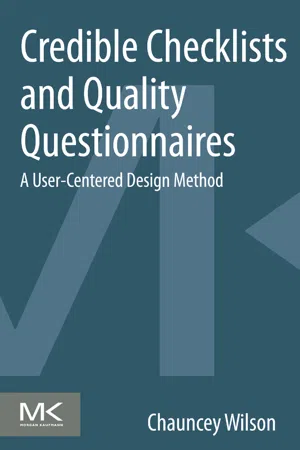The important thing is not to stop questioning. Curiosity has its own reason for existing.
Overview of Questionnaires and Surveys
When Should You Use Questionnaires and Surveys?
Strengths
Weaknesses
What Do You Need to Use Questionnaires and Surveys?
Personnel, Participants, and Training
Software
Documents and Materials
Procedures and Practical Advice
Planning and Developing the Questionnaire and Survey
Conducting the Questionnaire Study
Post-Survey Activities
Varying and Extending Questionnaires and Surveys via Mixed-Mode Surveys
Major Issues in the Use of Questionnaires and Surveys
Using Questionnaires to Compare Products Against a Norm
Wording of Questions
Questionnaire and Question Length
Recall and Memory
Ordering of Questions
Guidelines for Designing Response Categories
Rating Scales
Arbitrary Scaling
Likert Scaling
Semantic Differential Scales
Thurstone Scaling (Equal-Appearing Intervals)
Questionnaire Layout
Rewards and Incentives
Data Analysis
Types of Data
Analysis Techniques
Qualitative Analysis of Open-Ended Data
Exploratory Data Analysis
Frequency Counts
Measures of Central Tendency, Variability, and Shape
Cross Tabulations
References
Overview of Questionnaires and Surveys
A questionnaire is a written, online, or verbal tool for collecting data from individuals or groups that can be analyzed using qualitative and quantitative techniques. Building on the concepts introduced in Chapter 1, this chapter serves as a checklist on how to develop questions, questionnaires, and surveys. Developing a questionnaire is only one aspect of a survey. Other aspects of survey design include the following:
• Devising a sampling plan: Who are the respondents and how many respondents do you need to provide reliable and valid results? If you have a bad sample, your data might lead the product team astray.
• Developing a data analysis plan: What types of data will help you meet your goals? What analyses will help you understand the raw data?
• Recruiting respondents: Recruiting the target respondents is often a struggle, especially with privacy, opt-out policies, anti-spam policies, and difficulties getting directly at users (as opposed to customers).
• Writing cover letters and introductions that explain your study: Good cover letters can influence response rates.
• Sending out follow-up reminders: Reminders can be quite effective at encouraging responses, but they need to be written to be both gentle and persuasive so the respondent is not irritated.
• Analyzing the data: For large-scale studies, it is useful to consult with a business analyst or statistician who can guide you through data analysis issues such as inflated alpha levels (when you do multiple statistical tests on the same set of data, you are more likely to find spurious significant results) and confidence intervals (a way to assess the uncertainty due to sampling around statistics, such as means).
• Interpreting the data: What do your data mean? Interpretation involves both art and science. You need to understand how the sampling and context of your study can affect your results.
• Presenting the data to stakeholders: What is the best approach for presenting your data? How much do you present? How much detail do you need to ensure credibility?
This chapter focuses on the fundamentals of questionnaire design, practical tips, and some selected topics related to the broader survey process. A large collection of research on how to design, conduct, and analyze surveys (Bradburn, Sudman, & Wansink, 2004; Converse & Presser, 1986; Dillman, Smyth, & Christian, 2009; Foddy, 1993; Groves et al., 2009) is available, but the research can be confusing, contradictory, and complex. The intent of this chapter is to provide some reasonable practical advice, based on many years of reviewing and improving questionnaires, and not to debate in depth whether a five-point scale is necessarily better or worse than a seven-point scale.
The Long History of Surveys and Questionnaires
One of the earliest surveys on record is described in the Domesday Book, which reported on a land survey commissioned in 1085 by William the Conqueror to determine who owned land and other resources in England. The survey results were used to determine how much tax could be extracted from the landowners.
Around 800 years later, in the 1870s, Sir Francis Galton, the Victorian polymath and cousin of Charles Darwin, introduced the modern questionnaire method into psychology with his controversial book, English Men of Science: Their Nature and Nurture (Galton, 1874). Galton used the questionnaire method to examine whether interest in science was due to heredity or environment by sending questionnaires to 190 members of the Royal Society and asking questions about environment, birth order, and characteristics of the parents of Society members.
A questionnaire is often viewed as an easy way to gather data quickly from many respondents. However, the common belief that questionnaires are easy to design (often expressed as “let us just throw a questionnaire together” by those with limited questionnaire design experience) is a myth. The design of questionnaires and surveys is a complex process that involves many, sometimes conflicting, considerations (Dillman, 2000, 2007; Dillman et al., 2009; Kirakowski, 2000; Nemeth, 2004; Robson, 2002; Sudman, Bradburn, & Schwarz 1996), including some basic assumptions:
• The questionnaire is tapping the concepts of interest.
• The potential respondents are competent sources of the information you need.
• The respondents are willing to commit the time to answer your questionnaire (this gets into relevance and extrinsic and intrinsic motivation).
• All of the respondents understand your questions in the same way.
• People will follow the rules of the survey and provide (to the best of their abilities) honest data.
This chapter describes the basic procedures for developing paper and online questionnaires and highlights some of the important considerations for designing questionnaires and conducting surveys, including the following:
• The structure of questions: When should you use open, closed, or mixed questions? Mixed questions include both specific responses and an open-ended “Other” response...
